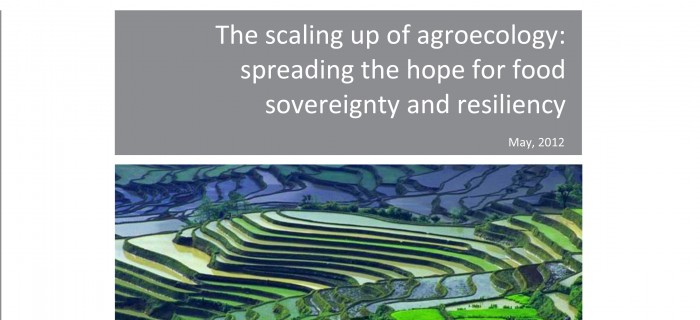The Scaling Up of Agroecology: Spreading the hope for food sovereignty and resiliency
A contribution to discussions at Rio+20 on issues at the interface of hunger, agriculture, environment and social justice
SOCLA’s Rio+20 position paper
Why industrial agriculture is no longer viable
The Green Revolution, the symbol of agricultural intensification not only failed to ensure safe and abundant food production for all people, but it was launched under the assumptions that abundant water and cheap energy to fuel modern agriculture would always be available and that climate would be stable and not change. Agrochemicals, fuel based mechanization and irrigation operations, the heart of industrial agriculture, are derived entirely from dwindling and ever more expensive fossil fuels. Climate extremes are becoming more frequent and violent and threaten genetically homogeneous modern monocultures now covering 80% of the 1500 million hectares of global arable land. Moreover industrial agriculture contributes with about 25-?30% of GHG emissions, further altering weather patterns thus compromising the world’s capacity to produce food in the future.
The ecological footprint of Industrial agriculture
In some of the major grain production areas of the world, the rate of increase in cereal yields is declining as actual crop yields approach a ceiling for maximal yield potential (Figure 1). When the petroleum dependence and the ecological footprint of industrial agriculture are accounted for, serious questions about the social, economic and environmental sustainability of modern agricultural strategies. Intensification of agriculture via the use of high-?yielding crop varieties, fertilization, irrigation and pesticides impact heavily on natural resources with serious health and environmental implications. It has been estimated that the external costs of UK agriculture, to be at least 1.5 to 2 billion pounds each year. Using a similar framework of analysis the external costs in the US amount to nearly 13 billion pounds per year, arising from damage to water resources, soils, air, wildlife and biodiversity, and harm to human health. Additional annual costs of USD 3.7 billion arise from agency costs associated with programs to address these problems or encourage a transition towards more sustainable systems. The US pride about cheap food, is an illusion: consumers pay for food well beyond the grocery store.
Due to lack of ecological regulation mechanisms, monocultures are heavily dependent on pesticides. In the past 50 years the use of pesticides has increased dramatically worldwide and now amounts to some 2,6 million tons of pesticides per year with an annual value in the global market of more than US$ 25 billion. In the US alone, 324 million kg of 600 different types of pesticides are used annually with indirect environmental (impacts on wildlife, pollinators, natural enemies, fisheries, water quality, etc.) and social costs (human poisoning and illnesses) reaching about $8 billion each year. On top of this, 540 species of arthropods have developed resistance against more than 1000 different types of pesticides, which have been rendered useless to control such pests chemically (Figure 2).
Stay in the loop with Food First!
Get our independent analysis, research, and other publications you care about to your inbox for free!
Sign up today!Although there are many unanswered questions regarding the impact of the release of transgenic plants into the environment which already occupy > 180 million hectares worldwide, it is expected that biotech crops will exacerbate the problems of conventional agriculture and, by promoting monoculture, will also undermine ecological methods of farming. Transgenic crops developed for pest control emphasize the use of a single control mechanism, which has proven to fail over and over again with insects, pathogens and weeds. Thus transgenic crops are likely to increase the use of pesticides as a result of accelerated evolution of ‘super weeds’ and resistant insect pest strains. Transgenic crops also affect soil fauna potentially upsetting key soil processes such as nutrient cycling. Unwanted gene flow from transgenic crops may compromise via genetic pollution crop biodiversity (i.e. maize) in centers of origin and domestication and therefore affect the associated systems of agricultural knowledge and practice along with the millenary ecological and evolutionary processes involved.


 Help Food First to continue growing an informed, transformative, and flourishing food movement.
Help Food First to continue growing an informed, transformative, and flourishing food movement.




